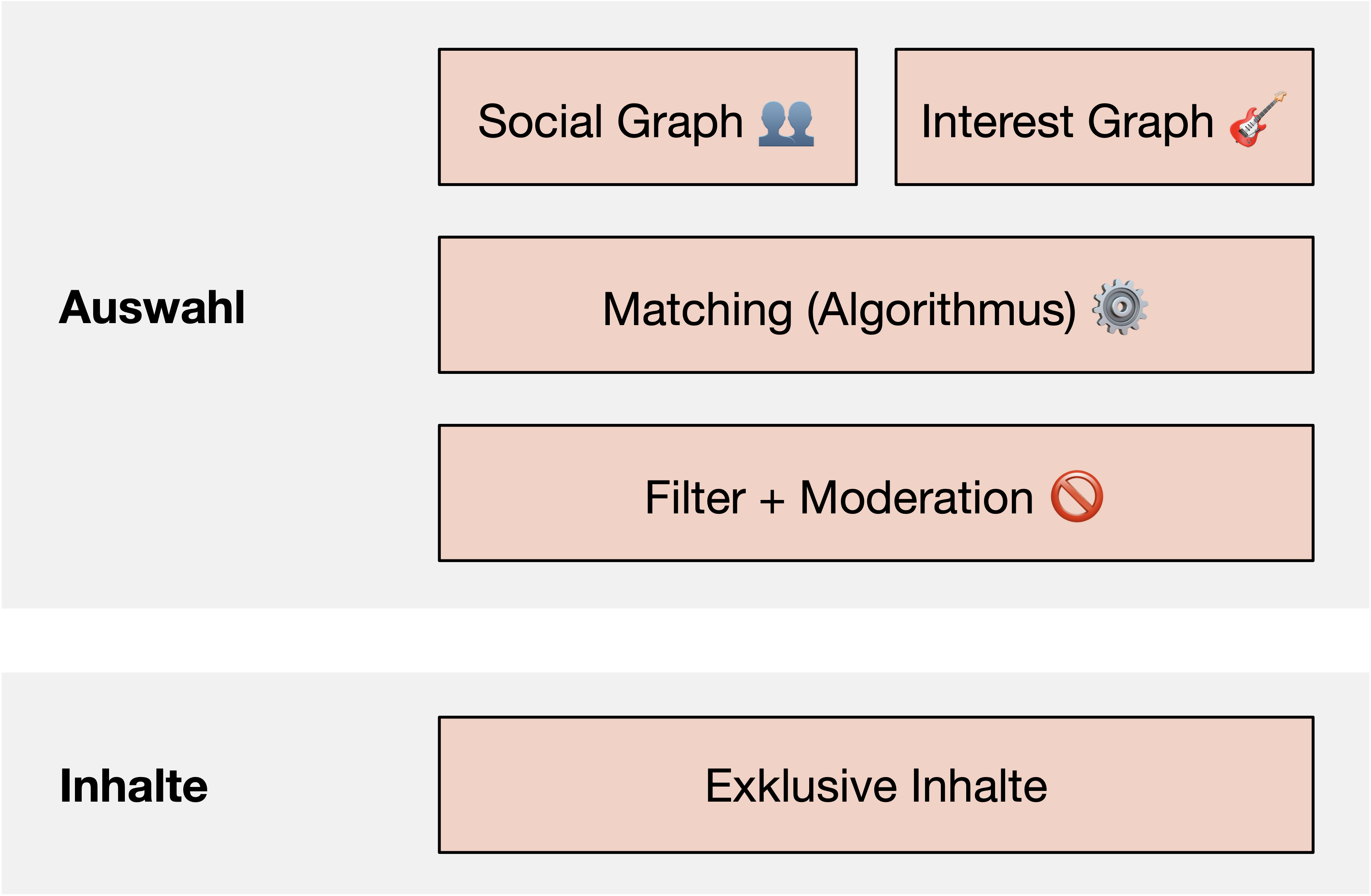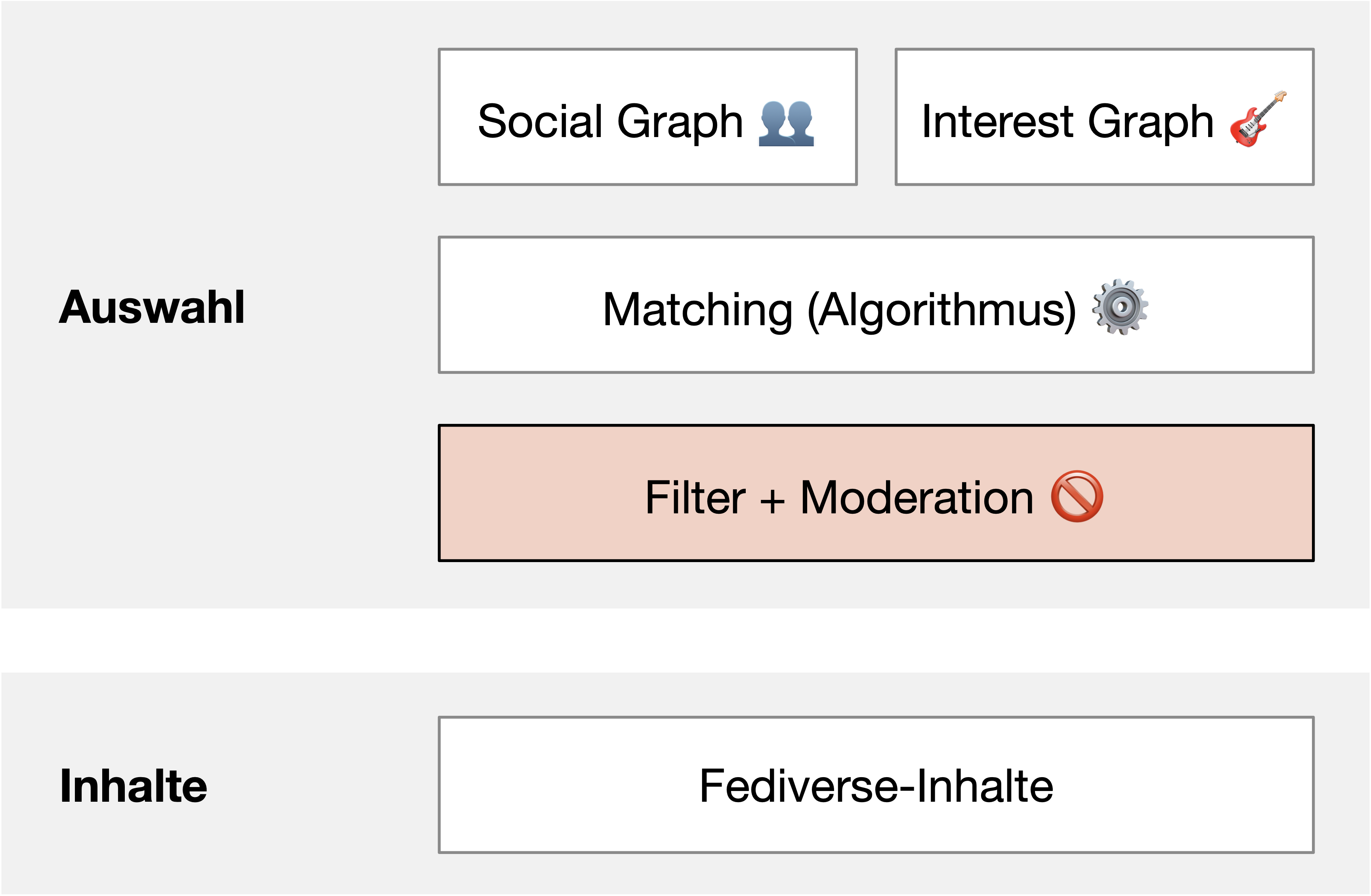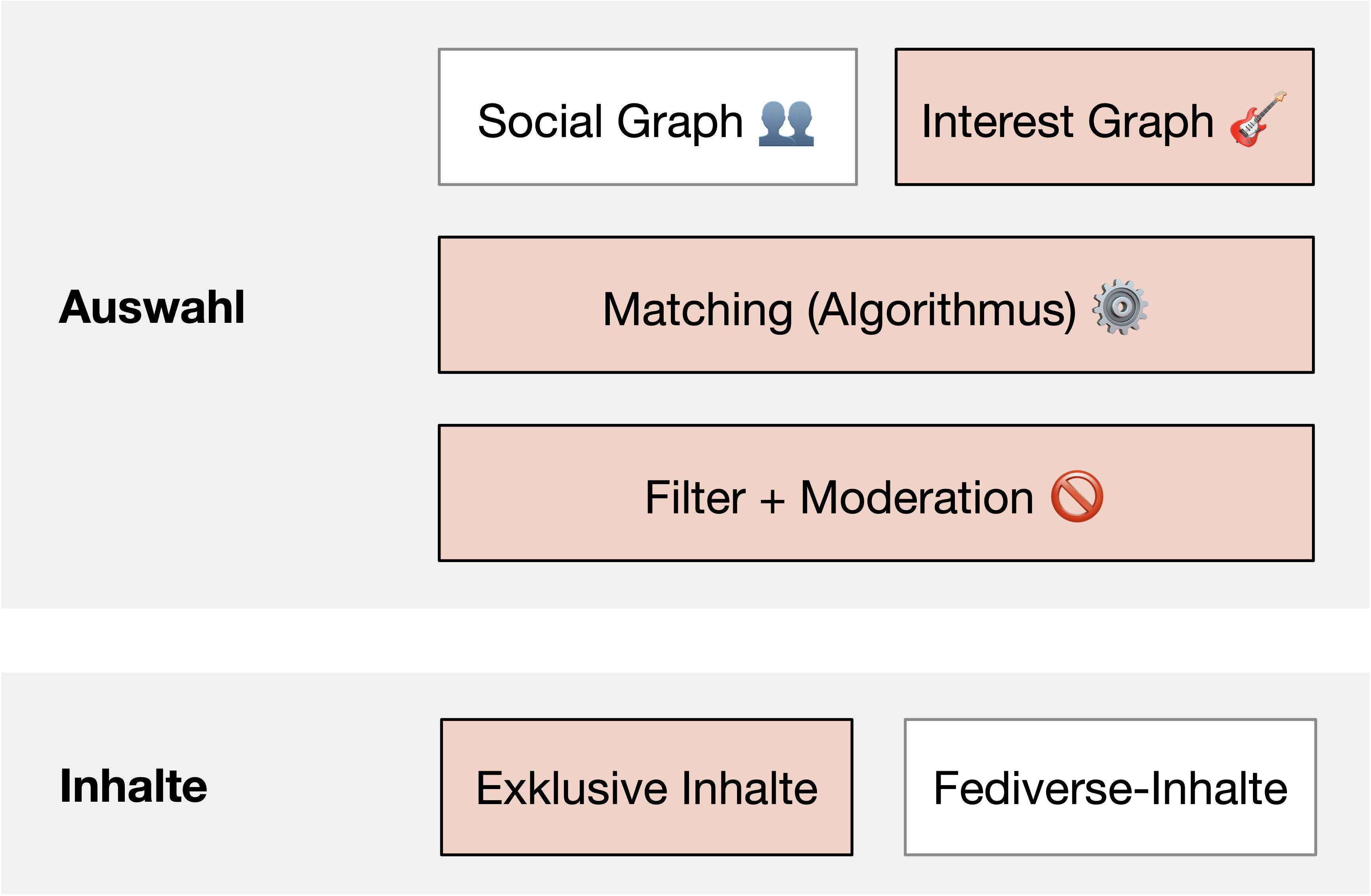- Platforms bridge needs with outcomes, storing our contacts (“Social Graph”) and interests (“Interest Graph”).
- Platforms like Instagram and Twitter provide an all-in-one solution: Social Graph, algorithms, and exclusive content. Thus, when users migrate from one platform to another, they have to build their feed all over again.
- The Fediverse decouples algorithms, the Social Graph, and content. This opens doors to entirely new business models and services.
What do Instagram, Amazon, and Google have in common? Answer:
“They generate value to the extent they create meaningful connections.”
– [[The Power of Platforms – Politics in the Era of Internet Giants (Michael Seemann, 2021)|Michael Seemann]]
Meaningful connections are those exclusively fostered by the platform:
- Google introduces me to websites I wasn’t familiar with.
- Amazon presents me with exclusive deals.
- Instagram constantly serves me new Reels, some of which aren’t even found on TikTok.
Platforms match needs with results, often leveraging an algorithm. This algorithm typically uses a “graph” – a digital map of my contacts (Social Graph) and interests (Interest Graph).
Platforms didn’t create these graphs; after all, my interests are my own, unique or not. My graph existed long before the platform and will stay with me forever.
Platforms utilize these graphs in diverse ways. For instance, Google processes my search query, infuses some of my Interest Graph, and leads me to a site that has no association with Google. Can a link signify a “meaningful connection?” Earning Google $225 billion annually(!) with such links: evidently, yes.
Spotify, TikTok, and Instagram function differently. Images, videos, and texts on the Instagram platform aren’t just anywhere on the internet – they’re exclusive to Instagram. Such closed platforms offer an integrated solution:

This strategy initially limits what the platform can connect. But it gives a massive edge: It can appropriate my graph.
Wait, didn’t we agree my interests and contacts are mine? Sure. But the machine-readable version is now in Facebook’s database, making it challenging to move to another platform. I’d have to start from scratch.
This phenomenon is the so-called “Lock-In” effect, and many despise it. Thus, the EU grants a “data portability” right, theoretically allowing me to move my personal data and feed to another platform. But in reality, it rarely happens. People want their Social Graph. Otherwise, they’d need to rebuild their feed meticulously.
Regrettably, the aforementioned law prohibits this. After all, my friends didn’t consent to their contact details being uploaded on any random platform. While the regulation has good intentions, it inadvertently reinforces the Lock-In effect.1
Shifting Ground Rules
The Fediverse aims to resolve these issues. The concept behind the Fediverse is almost as old as the internet itself. It gained traction recently, especially with Mastodon’s rise. Still, most online users have never encountered the term “Fediverse” until last weekend. As 100 million people signed up for Instagram’s new social network, Threads, they came across this statement:
“Future versions of Threads will be compatible with the Fediverse. The Fediverse is a novel kind of social media network, allowing users to follow and interact with each other across different platforms like Mastodon.”
What’s this Fediverse? It’s an opportunity to build a Social Graph not confined to a single platform. Delving deep into its mechanism would be exhaustive (highlighting one of its issues), but for simplicity, think of the Fediverse akin to email. I can follow anyone registered on a social network… and it just works.
Threads will truly be able to connect with other social networks, marking a seismic shift2. Especially considering why the app’s developers chose this direction. Not due to regulatory bodies or monopoly commissions but because they see it as the modern way:
“If you decide to leave Threads one day, you should be able to take your audience with you. [We aim to] be a place where you don’t feel tethered forever. […] I believe this is the general direction things are headed.”
If the Fediverse represents “the direction things are headed,” it heralds a wave of new business models and services – primarily since the Social Graph, algorithms, and content are decoupled. Here are four potential models:
1️⃣ The Perfect Feed
Value Proposition: The best for you from all social networks.
TikTok has proven that a social network can operate without a social graph. It’s sufficient to capture users’ interests and match them with all the content of a network. What’s fascinating about a “TikTok for the Fediverse” is that the content wouldn’t even come from the platform itself – it would merely provide the algorithm. This paves the way for many smaller apps, and by the way, they don’t necessarily have to feel like TikTok 🙏.

2️⃣ Filter as a Service
Value Proposition: Your feed from {Mastodon / Threads / …}, minus the hate.
Moderation was once termed the “main product” of every social platform3. The work behind it can be…
- centrally managed (like Facebook does),
- outsourced to moderated communities (like Mastodon does),
- or turned into a standalone product. Some believe that “Moderation as a Service” could be an industry of the future.
Would I download an app that automatically filters hate speech from my feed? Absolutely.

3️⃣ Gated Community+
Value Proposition: Exclusive content, combined with the entire Fediverse.
This is precisely what Threads is doing, but the concept isn’t limited to networks with 100 million users. Any conceivable niche – from local communities to dental technicians – could potentially have their own specialized social network in the future, with unique features and content. Users can then choose which posts to share with the broader world and which to keep within their sphere.

These thought experiments indicate that new types of apps are conceivable, and it’s not far-fetched to think they can be monetized. Currently, the Fediverse often hears criticisms about limited monetization opportunities. If you’re hoping for a centralized, massive money-printer like Facebook, then that’s probably true.
But do we even want that? Wouldn’t it be nice if the future consisted of various successful business models? To me, that’s a rhetorical question.
-
The law guarantees “the right to data portability shall not adversely affect the rights and freedoms of others” – Guidelines on the right to data portability (Working Party Article 29, 2017). Ben Thompson comments: “This forbids what I suggested: easily recreating one’s own social graph in other networks… The most valuable data (from a business perspective) is the social graph, not the updates and photos which now must be portable. This means Facebook’s position is much more secure thanks to (sensible!) regulation.” – The GDPR and Facebook and Google, Intelligent Tracking Prevention, Data Portability and Social Graphs (Ben Thompson, 2017) ↩︎
-
It’s only an announcement, but I (and most industry insiders) believe they’re earnestly working on it. The chaos at Twitter was too tempting not to expedite the launch of Instagram Threads, even if the Fediverse connection isn’t ready yet. ↩︎
-
“In many ways, content moderation is the primary product of any social business” – [[Can ActivityPub save the internet? (David Pierce, 2023)]] ↩︎
